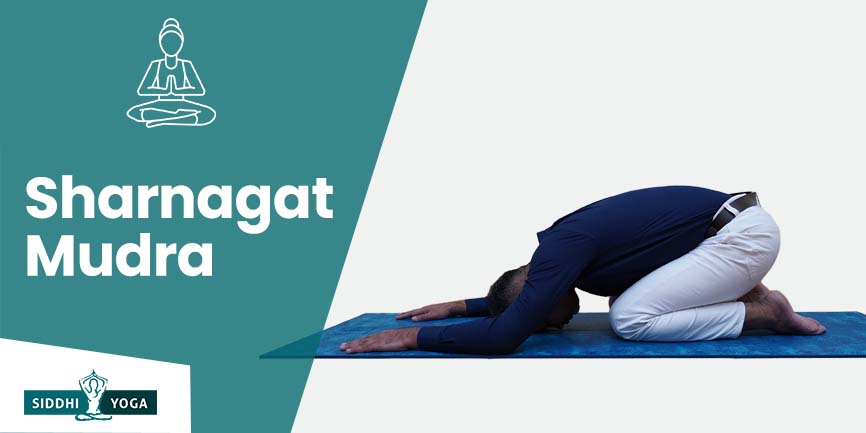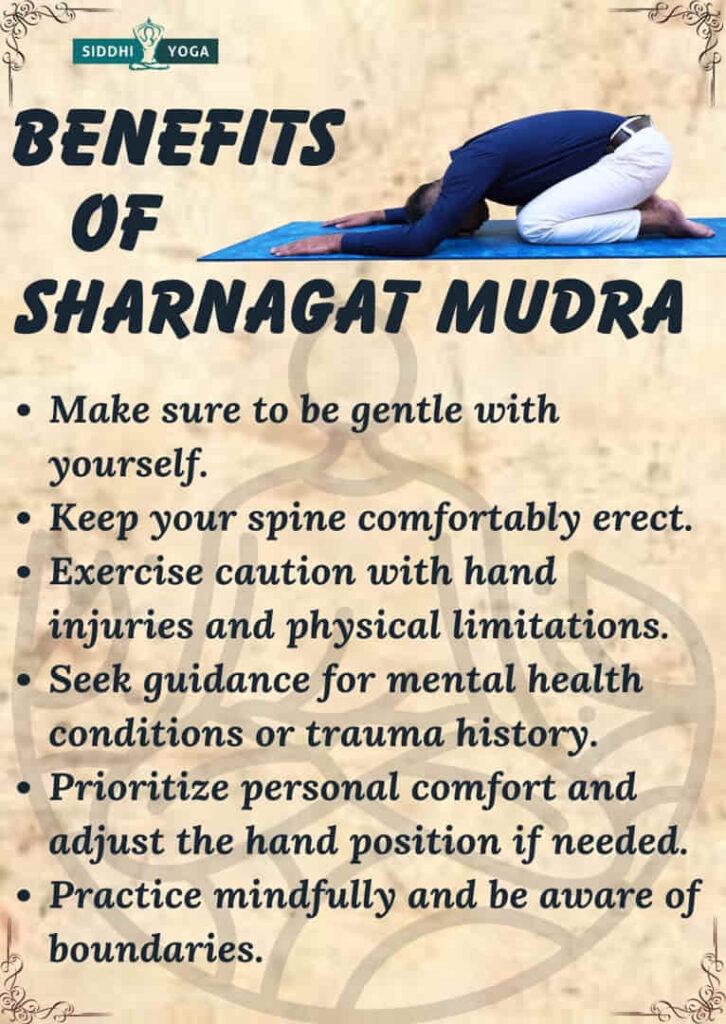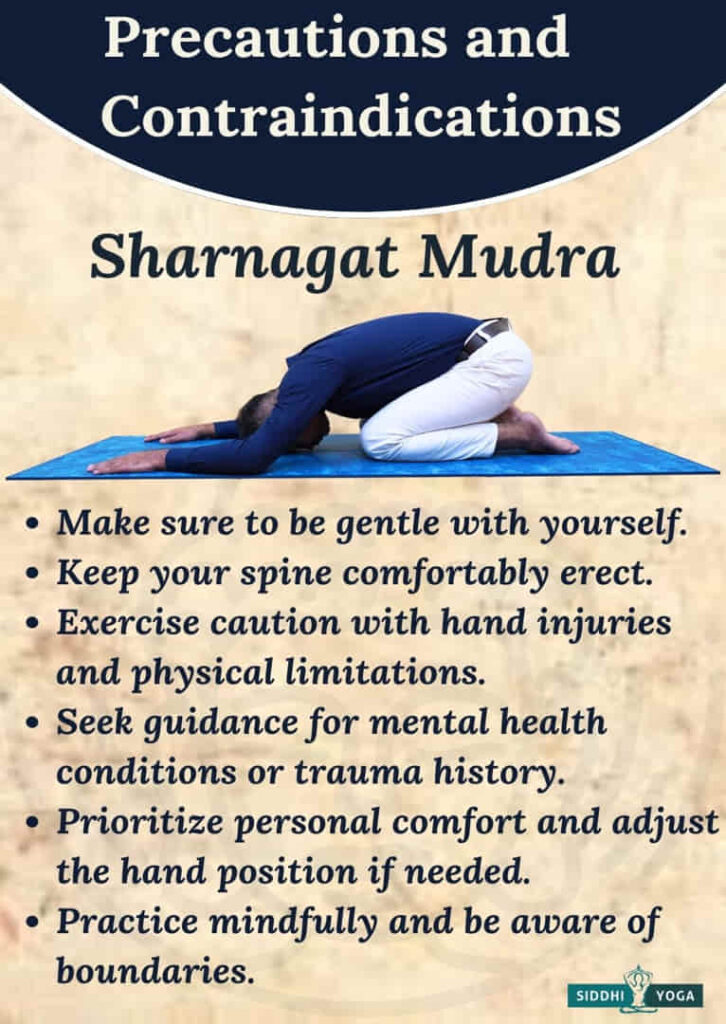
Discover the meaning, benefits, and how to do Sharnagat Mudra and how Sharnagat Mudra can help you with your anxiety and depression.
Definition – What is Sharnagat Mudra and its Meaning, References, and Mythology?
Sharnagat Mudra is type of Kaya Mudra or Body Mudra. Sharnagat Mudra is quite similar to Balasana (Some texts refer to it as Shashank Asana) or Child’s Pose. Similar to other Kaya Mudras, Sharnagat Mudra also assumes specific bodily postures. Let us simplify it by breaking it down into two parts.
Sharnagat – the word “Sarnagat” has a Sanskrit origin. The word itself is made of two different Sanskrit metals.
Sharan+Aagat
Sharan means “surrendering to something.”
Aagat means “to come.”
Sharnagat can be translated as “To come and surrender.”
Mudra – the word “Mudra” here refers to Kaya Mudra or Body Mudra.
This Mudra has very therapeutic effects on our body. Notice each part of your body. If you experience any tightness, try to bring your awareness to the part where you are experiencing that sensation and convince it to relax. This helps to relax like you are relaxing on the lap of Mother Nature. You feel relaxed. You feel that all of your worries have started to fade away. You surrender to Mother Nature. And as they say, “nature heals everything.” Do not let any thought hamper the state of surrender. Accept your thoughts without indulging in yourself into your thoughts.
This Mudra helps control anger-related issues, so it is highly beneficial for those with such issues. Besides this, this Mudra activates the Parasympathetic Nervous System, which helps improve digestion.
Alternate Name of Sharnagat Mudra
Surrender Pose.
How to Do Sharnagat Mudra?
- This Mudra falls under the category of Kaya Mudras, so it includes assuming bodily posture.
- First, come to the Dandasana (or the Staff Pose) by extending the legs forward and keeping the spine erect when your arms are resting by the sides.
- Now, bend your knees and place them underneath your glutes one by one.
- Inhale and lift your hands completely up towards the sky and join them together in Anjali Mudra (or Namaste Mudra, this Mudra can be assumed later as well) while comfortably erecting the spine to its maximum length.
- With an exhalation, empty your stomach while drawing your stomach in and bending forward until you can rest your arms and your head down.
- Now, relax your entire body and surrender yourself completely.
- Let gravity hold your body rather than you holding yourself.
- Keep your eyes gently closed.
- Now, start to meditate. Distant yourself from your thoughts.
- Witness your breath without losing awareness of your breath. But once you get better with your practice, you also lose the awareness of your breath.
- You can practice it with different types of meditation techniques, but without falling asleep.
Sharnagat Mudra Benefits

- It soothes the mind and relaxes the entire body. You feel as if you are not burdened at all.
- You feel the grounding. You feel that I can surrender without needing to worry, without needing to stay alert or cautious.
- It reduces negative emotions such as stress, anxiety, anger, etc.
- As it calms the mind, it improves our body’s healing response.
- It helps to concentrate and makes you feel more focused.
- If you have too many thoughts in your mind that you cannot relax, then practicing this will result in a clearer thought process.
Sharnagat Mudra Precautions and Contraindications

Similar to all other Mudra practices, it has no side effects.
However, there are a few things to consider:
- Make sure you are not hurting your knees. If you experience knee pain, we recommend using a towel or blanket underneath your knees.
- If your hips are lifting off, you may need to use a blanket or towel underneath your knees. This will ease you a little. However, this is temporary. A more permanent solution would be to mobilize your hip joint and increase the Range of Motion.
- Make sure to be gentle with yourself.
- Keep your spine comfortably erect.
When and how long to do Sharnagat Mudra?
- If you want to get better with your meditation practices, try to relax completely in a thoughtless state. You will become more meditative and can maximize the outcomes of your practice.
- You can practice this if you find yourself surrounded by stressors. It will help you to distance yourself from all the negativity.
- If you are experiencing any sleep-related issues, you should try it.
- It serves great value if you have stress, memory loss, and digestive issues.
Morning is the ideal time to do any yoga or Mudra. Our brain is at its best in the morning and during the daytime. So, you are more likely to be able to concentrate easily. Therefore, you should practice this Mudra from 4 am and 6 am to get the most effective outcomes.
If you are having difficulty with this during the morning hours, you can do this Mudra later in the evening too.
Practicing this Mudra for a minimum of 30-40 minutes daily is recommended. Whether you wish to complete it in one stretch or two threes that last between 10 and 20 minutes, it’s up to you. Based on research, the best way to practice an exercise for at least 20 minutes is to get the best benefits of that particular Mudra.
Breathing in Sharnagat Mudra
- Deep Breathing.
Visualization in Sharnagat Mudra
- Visualize that you are hugging the most positive person in your life.
- Try to remember that feeling. How do you feel? When you do that.
- Experience that joy, that calmness, that feeling. Feel it. Try not to name it.
Affirmation in Sharnagat Mudra
“Hey, mighty divine consciousness. I have come here to surrender.”
Conclusion
Sharnagat Mudra is a helpful tool for those seeking inner peace and compassion. This Mudra can be done by anyone, regardless of their level of experience with yoga or meditation. The benefits of the Sharnagat Mudra include promoting feelings of safety and security, helping to release stored emotional trauma, and increasing levels of compassion. If you are interested in learning more about mudras and how to use them for your health and well-being, consider signing up for our Mudras Certification Course. This course will teach you all 108 mudras, their benefits, and how to use them correctly.